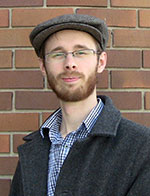![]() Last weekend, I ended up spending Holy Saturday evening at the Orthodox cathedral in town. My own church doesn’t hold services that day, so I took a friend’s advice to sit in on the Orthodox service. I wanted to reflect upon Christ in the tomb and celebrate his resurrection, and I wanted to do both in the company of other Christians. And while the service allowed opportunity for these things, it also served as a reminder of something else: namely, how traditional liturgy can act as a type of universal language for Christians, offering a glimpse of worship as we will one day experience it in heaven.
Last weekend, I ended up spending Holy Saturday evening at the Orthodox cathedral in town. My own church doesn’t hold services that day, so I took a friend’s advice to sit in on the Orthodox service. I wanted to reflect upon Christ in the tomb and celebrate his resurrection, and I wanted to do both in the company of other Christians. And while the service allowed opportunity for these things, it also served as a reminder of something else: namely, how traditional liturgy can act as a type of universal language for Christians, offering a glimpse of worship as we will one day experience it in heaven.
I’m sure some of you reading this will be surprised at that assertion, particularly if you come from a more contemporary-driven worship background. For many people, liturgical worship has become synonymous with dead worship. Repeating the same prayers, chanting the same chants week in and week out? Surely it just becomes mere words, said without meaning – a matter of habit as opposed to spontaneous faith.
That may be the case for some (regrettably, no doubt, for too many Christians attending liturgical services). But that a thing can be used inappropriately doesn’t mean that the thing itself is bad. Approached rightly, liturgy offers exactly what I said before: a glimpse of heavenly worship. When we pray the “tired old prayers” so often disparaged by today’s Christians, we in effect proclaim our unity with the Church through the ages. We pray the same prayers Christians a thousand years ago prayed. In fact, we pray the prayer Christ himself prayed. And we confess the same creedal faith the Church has confessed for nearly two millenia. Likewise, we reflect each week that the worship we render here on earth is joined with that offered in heaven. “With angels, archangels and all the company of heaven,” the preface to the Sanctus begins, “we laud and magnify your glorious name, evermore praising you and saying: ‘Holy, holy, holy is the Lord God Almighty!'”
The liturgy fosters a sense of timelessness, of worship as something not bound to any particular century or culture. It reaches back to antiquity; it points us forward to the unending depths of eternity. We recognize ourselves as part of that unbroken chain, recognize the unity of the Church past, present, and future.
The Orthodox Holy Saturday service reminded me of that truth in a new way. It reached back as we listened to numerous readings from the Old and New Testaments. We declared the Christian faith according to the Nicene Creed, as it was prepared in the 4th century A.D. Likewise, the sermon was a reading from John Chrysostom’s writings, also from the 4th century. We used liturgical structures developed by the ancient church and used by many Christians over the following centuries. We sang, as so many before us have sung, the Paschal Troparion, “Christ is risen from the dead / Trampling death by death! / And upon those in the tombs / Bestowing life.”
Likewise we proclaimed to one another the glorious message of Easter: “Christ is risen!” / “Truly he is risen!” In fact, it was that Paschal greeting which made me reflect anew upon the universality of liturgy. And the reason for that was because we didn’t just say “Christ is risen!” in English. We said it in numerous languages. Saturday’s service was the most culturally diverse I’ve ever attended. The priest had a crisp, east-European accent, and he greeted the various people groups in the church in their heart languages. “Christ is risen!” he cried to the English, and we shouted back “Truly he is risen!” He proclaimed the same thing in Greek, and the Greeks responded in joy. He shouted it in Amharic, and the Ethiopians echoed in praise. He called the same in Russian, in Ukrainian, in German, and in a number of other Eastern European languages (and perhaps one Asian) that I could not identify, and every time the people declared the Good News of Jesus Christ.
Though from very different cultural backgrounds, we were all united in that moment. Though speaking different languages, we all prayed and praised God with one voice. And the words of Revelation played through my mind: “I looked and there before me was a great multitude that no one could count, from every nation, tribe, people and language, standing before the throne and in front of the Lamb. They were wearing white robes and were holding palm branches in their hands. And they cried out in a loud voice: “Salvation belongs to our God, who sits on the throne, and to the Lamb.” (7:9-10).
Every nation. Every language. One voice. “He is risen! Truly He is risen! Kristos tenestwal! Wahrlich ist er erstanden! Christos anesti!”
“Χριστός ανέστη!”


